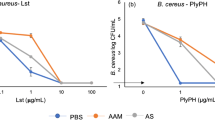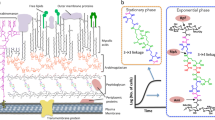Abstract
Cell wall hydrolases are enzymes that cleave bacterial cell walls by hydrolyzing specific bonds within peptidoglycan and other portions of the envelope. Two major sources of hydrolases in nature are from hosts and microbes. This study specifically investigated whether cell wall hydrolytic enzymes could be employed as exogenous reagents to augment the efficacy of antimicrobial agents against mycobacteria. Mycobacterium smegmatis cultures were treated with ten conventional antibiotics and six anti-tuberculosis drugs—alone or in combination with cell wall hydrolases. Culture turbidity, colony-forming units (CFUs), vital staining, and oxygen consumption were all monitored. The majority of antimicrobial agents tested alone only had minimal inhibitory effects on bacterial growth. However, the combination of cell wall hydrolases and most of the antimicrobial agents tested, revealed a synergistic effect that resulted in significant enhancement of bactericidal activity. Vital staining showed increased cellular damage when M. smegmatis and Mycobacterium bovis bacillus Calmette–Guérin (M. bovis BCG) were treated with both drug and lysozyme. Respiration analysis revealed stress responses when cells were treated with lysozyme and drugs individually, and an acute increase in oxygen consumption when treated with both drug and lysozyme. Similar trends were also observed for the other three enzymes (hydrolase-30, RipA-His6 and RpfE-His6) evaluated. These findings demonstrated that cell wall hydrolytic enzymes, as a group of biological agents, have the capability to improve the potency of many current antimicrobial drugs and render ineffective antibiotics effective in killing mycobacteria. This combinatorial approach may represent an important strategy to eliminate drug-resistant bacteria.







Similar content being viewed by others
References
Keren I, Minami S, Rubin E, Lewis K (2011) Characterization and transcriptome analysis of Mycobacterium tuberculosis persisters. mBio 2:e00100–e00111
Sotgiu G, Sulis G, Matteelli A (2017) Tuberculosis-a Wold Health Organization perspective. Microbiol Spectr. https://doi.org/10.1128/microbiolspec.TNMI7-0036-2016
Floyd K, Glaziou P, Zumla A, Raviglione M (2018) The global tuberculosis epidemic and progress in care, prevention, and research: an overview in year 3 of the End TB era. Lancet Respir Med 6(4):299–314. https://doi.org/10.1016/S2213-2600(18)30057-2
Nahid P, Dorman SE, Alipanah N, Barry PM, Brozek JL, Cattamanchi A et al (2016) Official American Thoracic Society/Centers for Disease Control and Prevention/Infectious Diseases Society of America Clinical Practice Guidelines: treatment of drug-susceptible tuberculosis. Clin Infect Dis 63:147–195. https://doi.org/10.1093/cid/ciw376.
Munro SA, Lewin SA, Smith HJ, Engel ME, Fretheim A, Volmink J (2007) Patient adherence to tuberculosis treatment: a systematic review of qualitative research. PLoS Med 4:1230–1245. https://doi.org/10.1371/journal.pmed.0040238
WHO (2016) Global tuberculosis report. World Health Organization, Geneva
Brennan PJ, Nikaido H (1995) The envelope of mycobacteria. Annu Rev Biochem 64:29–63
Draper P (1998) The outer parts of the mycobacterial envelope as permeability barriers. Front Biosci 3:1253–1261
McNeil M, Daffé M, Brennan PJ (1990) Evidence for the nature of the link between the arabinogalactan and peptidoglycan of mycobacterial cell walls. J Biol Chem 265:18200–18206
Rosen BP, Mobashery S (1998) Resolving the antibiotic paradox progress in understanding drug resistance and development of new antibiotics. Plenum Press, New York
Niederweis M (2003) Mycobacterial porins - new channel proteins in unique outer membranes. Mol Microbiol 49:1167–1177. https://doi.org/10.1046/j.1365-2958.2003.03662.x
Deng LL, Humphries DE, Arbeit RD, Carlton LE, Smole SC, Carroll JD (2005) Identification of a novel peptidoglycan hydrolase CwlM in Mycobacterium tuberculosis. Biochim Biophys Acta 1747:57–66
Shockman GD, Höltje JV (1994) Microbial peptidoglycan (murein) hydrolases. In: Ghuysen JM, Hakenbeck R (eds) New comprehensive biochemistry. Elsevier, Amsterdam, pp 131–166
Callewaert L, Michiels CW (2010) Lysozymes in the animal kingdom. J Biosci 35:127–160
Ercan D, Demirci A (2015) Recent advances for the production and recovery methods of lysozyme. Crit Rev Biotechnol 36:1078–1088
Catalão MJCA, Gil F, Moniz-Pereira J, Pimentel M (2010) The mycobacteriophage Ms6 encodes a chaperone-like protein involved in the endolysin delivery to the peptidoglycan. Mol Microbiol 77:672–686. https://doi.org/10.1111/j.1365-2958.2010.07239.x
Mahapatra S, Piechota C, Gil F, Ma Y, Huang H, Scherman MS et al (2012) Mycobacteriophage Ms6 LysA: a peptidoglycan amidase and a useful analytical tool. Appl Environ Microbiol 79:768–773
Grover N, Paskaleva EE, Mehta KK, Dordick JS, Kane RS (2014) Growth inhibition of Mycobacterium smegmatis by mycobacteriophage-derived enzymes. Enzyme Microb Technol 63:1–6
Piuri M, Hatfull GF (2006) A peptidoglycan hydrolase motif within the mycobacteriophage TM4 tape measure protein promotes efficient infection of stationary phase cells. Mol Microbiol 62:1569–1585
Connolly LE, Edelstein PH, Ramakrishnan L (2007) Why is long-term therapy required to cure tuberculosis? PLoS Med 4:120. https://doi.org/10.1371/journal.pmed.0040120.
Djurkovic S, Loeffler JM, Fischetti VA (2005) Synergistic killing of Streptococcus pneumoniae with the bacteriophage lytic enzyme cpl-1 and penicillin or gentamicin depends on the level of penicillin resistance. Antimicrob Agents Chemother 49:1225–1228
Hett EC, Rubin EJ (2008) Bacterial growth and cell division: a mycobacterial perspective. Microbiol Mol Biol Rev 72:126–156
Dwyer DJ, Belenky PA, Yang JH, MacDonald IC, Martell JD, Takahashi N et al (2014) Antibiotics induce redox-related physiological alterations as part of their lethality. Proc Natl Acad Sci USA 111:2100–2109. https://doi.org/10.1073/pnas.1401876111
Asensi V, Fierer J (1991) Synergistic effect of human lysozyme plus ampicillin or beta-lysin on the killing of Listeria monocytogenes. J Infect Dis 163:574–578
Hett EC, Chao MC, Steyn AJ, Fortune SM, Deng LL, Rubin EJ (2007) A partner for the resuscitation-promoting factors of Mycobacterium tuberculosis. Mol Microbiol 66:658–668
Sassetti CM, Boyd DH, Rubin EJ (2003) Genes required for mycobacterial growth defined by high density mutagenesis. Mol Microbiol 48(1):77–84
Smith I (2003) Mycobacterium tuberculosis pathogenesis and molecular determinants of virulence. Clin Microbiol Rev 16:463–496. https://doi.org/10.1128/cmr.16.3.463-496
Daniel A, Euler C, Collin M, Chahales P, Gorelick KJ, Fischetti VA (2010) Synergism between a novel chimeric lysin and oxacillin protects against infection by methicillin-resistant Staphylococcus aureus. Antimicrob Agents Chemother 54:1603–1612
Wallace RJ, Nash DR, Tsukamura M, Blacklock ZM, Silcox VA (1988) Human disease due to Mycobacterium smegmatis. J Infect Dis 158(1):52–59
Lu T, Zhao X, Li X, Hansen G, Blondeau J, Drlica K (2003) Effect of chloramphenicol, erythromycin, moxifloxacin, penicillin and tetracycline concentration on the recovery of resistant mutants of Mycobacterium smegmatis and Staphylococcus aureus. J Antimicrob Chemother 52(1):61–64
Deng L, Mikusova K, Robuck KG, Scherman M, Brennan PJ, Mcneil MR (1995) Recognition of multiple effects of ethambutol on metabolism of mycobacterial cell envelope. Antimicrob Agents Chemother 39:694–701
Au MB, Siswando L, Hall J, Weinberg JS, Deng LL (2017) Identification of native Mycobacterium Smegmatis cell wall degradative enzymes using electrophoretic fluorescent assays. Int Educ Res J 3:31–34
Mukamolova GV, Kaprelyants AS, Young DI, Young M, Kell DB (1998) A bacterial cytokine. Proc Natl Acad Sci USA 95:8916–8921
Aguilar-Pérez C, Gracia B, Rodrigues L, Vitoria A, Cebrián R, Deboosère N, Song OR, Brodin P, Maqueda M, Aínsa JA (2018) Synergy between Circular Bacteriocin AS-48 and Ethambutol against Mycobacterium tuberculosis. Antimicrob Agents Chemother 62(9):1–13. https://doi.org/10.1128/AAC.00359-18
Acknowledgements
The authors thank Drs. Igor Kramnik, Michael Kirber (BU Cellular Imager Core) and Raman Sahadevan for their technical advice and guidance. We thank Linda L. Deng for her graphic design assistance needed to improve some of the figures. We would also like to thank Lisa Siswanto, Albert Jones, Mario V. Lopez, Sonia Benzor, Keri LaBelle, Anjali Taneja and Mike M. Liu for their technical assistance. This research was supported by Public Health Service Grant AI-45617 from the National Institute of Allergy and Infectious Diseases (NIAID), a research Grant RG-107N from American Lung Association, a pilot Grant 9500300388 from the BU CTSI and Evans Foundation, and a grant through the BU Undergraduate Research Opportunities Program (UROP). The studies were conducted in the Analytical Instrumentation Core (AIC) at BUMC.
Author information
Authors and Affiliations
Corresponding author
Additional information
Publisher’s Note
Springer Nature remains neutral with regard to jurisdictional claims in published maps and institutional affiliations.
Electronic supplementary material
Below is the link to the electronic supplementary material.
Rights and permissions
About this article
Cite this article
Gustine, J.N., Au, M.B., Haserick, J.R. et al. Cell Wall Hydrolytic Enzymes Enhance Antimicrobial Drug Activity Against Mycobacterium. Curr Microbiol 76, 398–409 (2019). https://doi.org/10.1007/s00284-018-1620-z
Received:
Accepted:
Published:
Issue Date:
DOI: https://doi.org/10.1007/s00284-018-1620-z




